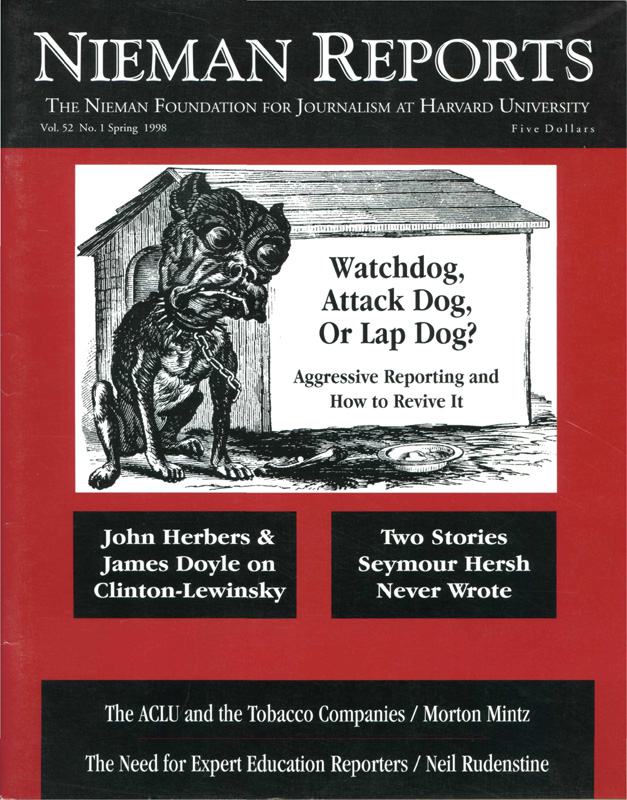BOSTON
To the Editor:
As a journalist and author (of “Asphalt Nation: How the Automobile Took Over America and How We Can Take It Back”), I was pleased to see the last issue of Nieman Reports concentrating on what I consider a central factor in American life: transportation. I was, however, surprised to see the weight given to road or even anti-road issues versus the broader subject—the importance of comprehensive coverage to new transportation needs, new times, and the next step beyond anti-road responses to congestion, pollution and environmental disquietude.
Although the issue offered some solutions to the ills of a road-oriented nation, very little attention went to relieving transportation problems through alternate forms of movement— streetcars taking hold, pedestrian advocates calming streets, bike paths growing, (trains, alas, still in the doldrums), etc.—and, above all, the land use planning and zoning needed to stop the vehicle miles we travel from doubling yet again in the next two decades. It is journalists who can point out the mindset that says “we invest in roads, we subsidize rail.” It is reporters who can fill in the specifics and the larger picture.
A few such journalists do exist. Yet compared to the coverage given automobiles and real estate sections week after week, they have a paltry role. Yes, individual articles cover transportation issues from road rage to airbags, SUV’s on steroids to welfare recipients without wheels to get to work. We learn of opposition to highway-fed sprawl or superstores. We read the economic consequences of a car-based culture (we spend twice as much of our GDP on transportation as any other industrial nation) and we know the social effects (55 million school-age kids driven by their weary “soccer moms” and the evermore immobilized elderly). The environmental implications become more obvious as awareness grows that the automobile causes almost half the emissions implicated in global warming. Yet, all the while, we fail to connect these fragments.
The link of such issues to the vast network of transportation concerns would have enriched your pages, as they would enrich the nation, if journalists became more diligent in addressing them.
JANE HOLTZ KAY
To the Editor:
As a journalist and author (of “Asphalt Nation: How the Automobile Took Over America and How We Can Take It Back”), I was pleased to see the last issue of Nieman Reports concentrating on what I consider a central factor in American life: transportation. I was, however, surprised to see the weight given to road or even anti-road issues versus the broader subject—the importance of comprehensive coverage to new transportation needs, new times, and the next step beyond anti-road responses to congestion, pollution and environmental disquietude.
Although the issue offered some solutions to the ills of a road-oriented nation, very little attention went to relieving transportation problems through alternate forms of movement— streetcars taking hold, pedestrian advocates calming streets, bike paths growing, (trains, alas, still in the doldrums), etc.—and, above all, the land use planning and zoning needed to stop the vehicle miles we travel from doubling yet again in the next two decades. It is journalists who can point out the mindset that says “we invest in roads, we subsidize rail.” It is reporters who can fill in the specifics and the larger picture.
A few such journalists do exist. Yet compared to the coverage given automobiles and real estate sections week after week, they have a paltry role. Yes, individual articles cover transportation issues from road rage to airbags, SUV’s on steroids to welfare recipients without wheels to get to work. We learn of opposition to highway-fed sprawl or superstores. We read the economic consequences of a car-based culture (we spend twice as much of our GDP on transportation as any other industrial nation) and we know the social effects (55 million school-age kids driven by their weary “soccer moms” and the evermore immobilized elderly). The environmental implications become more obvious as awareness grows that the automobile causes almost half the emissions implicated in global warming. Yet, all the while, we fail to connect these fragments.
The link of such issues to the vast network of transportation concerns would have enriched your pages, as they would enrich the nation, if journalists became more diligent in addressing them.
JANE HOLTZ KAY



